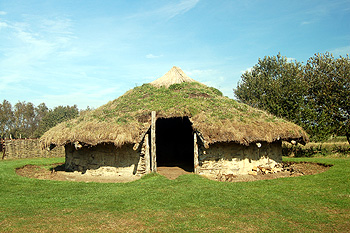Kempston in the New Stone Age and Bronze Age

A reconstruction of an Bronze Age round house at Flag Fen October 2011
Finds have made it clear that there has been human activity in Kempston for a very long time. This should not be surprising given the presence of a major and navigable river as it is thought that in earliest times rivers were the major arteries of travel and communication.
The Bedfordshire Historic Environment Record [HER] contains information on the county's historic buildings and landscapes and summaries of each entry can now be found online as part of the Heritage Gateway website. Gravel digging in the 19th and 20th centuries revealed s number of Neolithic and Bronze Age finds on the north side of Bedford Road as well as finds from the Paleaolithic, Mesolithic, Iron Age, Romano-British and Anglo-Saxon periods [HER 256]. One of these was a flint arrowhead which may be Neolithic or Bronze Age in date – flint tools continued to be used right through the Bronze Age as they were quicker to make and the raw material more readily to hand. In the same area a Neolithic scraper was found as well as a Bronze Age urn which indicates a cremation burial.
The modern housing site between Kempston Mill and Kempston Manor also produced finds from a number of periods including a small quantity of Neolithic flint flakes [HER 14853]. In 1936 a length of ditch was found when excavating a gravel pit between Hillgrounds Road and the river. It was apparently interrupted by a causeway. The ditch measured 90 metres and ran north-east to south-west. A Bronze Age beaker was found near the south-west end and at the north-east end was a crouched Neolithic skeleton. The site has been tentatively identified as a cursus. A cursus is the name given to Neolithic monuments which may have had a ceremonial function – they are a flat area between two banks and ditches and thus resembling a race course. "Course" is the meaning of the Latin cursus, the name being given to them by 18th century antiquarians. They can be as short as fifty yards or as long as six miles so this example, if it is indeed a curses, is one of the shorter ones.
Also in the area of Hillgrounds Road, at the site of the swimming pool, nineteen worked flint flakes were found [HER 15459]. They included two parts of a broken implement termed a rod, two small cores, part of a knife a small scraper, six waste flakes and seven probable waste flakes; there was also one complete rod. These are all Neolithic or early Bronze Age.
More Bronze Age activity has been discovered at the site of the modern Cutler Hammer sports ground at the corner of Cemetery Road and Kempston High Street [HER 17731]. This site has been subjected to archaeological evaluation including a geophysical survey. The results yielded the location of three ring ditches, probably indicating a former Bronze Age round barrows. None of them still contained human remains.
Finally two bronze spearheads have been found in Kempston. One was discovered in the 19th or early 20th century between Kempston and Elstow [HER 259] and dates from the middle Bronze Age. It has a leaf-shaped blade which has been damaged. It now resides in The Higgins. The other spearhead came from silts at Ford Mill [HER 15918]. Only the tip has survived.